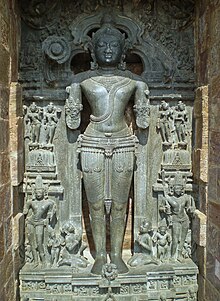Samba Purana
| Part of a series on |
| Hindu scriptures and texts |
|---|
 |
| Related Hindu texts |
The Samba Purana (
Content

Samba Purana is a text dedicated to the worship of Surya, the god of the sun. This text comprises a number of narratives dealing with creation, details of solar system, eclipses, geography of the earth, description of Surya and his attendants, construction of images of these deities, details of yoga, manners and customs, rites and rituals, recitations of mantras, and dāna (generosity).[2]
After the customary beginning in Chapter 1, the text consists the narrative of
In Chapter two, Samba, a son of Krishna was cursed to be afflicted by leprosy. In chapter 5, Samba was then advised by Narada to worship Surya. In Chapter 14, Samba engaged himself in tapas, meditating on Surya at Mitravan (identified by scholars as Multan) which came to be called Sambapur. In chapter 16, Samba discovered an idol of Surya midstream in Chandrabhaga (Chinab) river.
Chapters 26-27 of this text narrate the story of bringing the eighteen
History
R.C. Hazra in his Studies in the Upapuranas dates Samba Purana between 650-850 CE.[4] The text in Brāhmaparvan of the Bhavishya Purana is largely taken from the Samba Purana which is regarded to be older.[5][6][7]
Govindpur Inscription of Poet Gangadhar
An inscription of Saka 1059 (1137-38 CE) was discovered by Cunningham at Govindpur in the Nawada division of the Gaya district. It gives the account of Maga Brahmins being invited by Samba. The scholarly family of Gangadhar belonged to a clan of Maga Brahmins.
References
- ^ Tripathi (1983), pp. 38–68.
- ^ Hazra (2003), p. 284.
- ^ Dowson (2013), pp. 276–277.
- ^ Ahmad (2008).
- ^ Jha (2011).
- ^ Hohenberger (1967).
- ^ Glaesser (1969).
- ^ Ray (1931), p. 348.
- ^ Kielhorn (1894).
Bibliography
- Ahmad, Erfan (2008). Sāmba Purāna: a study (PDF) (Thesis). Aligarh, India: Aligarh Muslim University.
- Dowson, John (5 November 2013) [2000]. A Classical Dictionary of Hindu Mythology, and Religion, Geography, History. Routledge. ISBN 9781136390296. Retrieved 29 April 2017.
- Glaesser, Gustav (1969). "Review of Das Bhaviṣyapurāṇa (Münchener Indologische Studien vol. 5)". East and West. 19 (3/4): 511–513. JSTOR 29755461.
- Hazra, R.C. (2003) [1962]. "The Upapuranas". In Radhakrishnan, S. (ed.). The Cultural Heritage of India. Vol. 2. Kolkata: The Ramakrishna Mission Institute of Culture. ISBN 81-85843-03-1.
- Hohenberger, Adam (1967). Hoffmann, Helmut (ed.). Das Bhaviṣyapurāṇa. Münchener Indologische Studien. 5 (in German). Wiesbaden: Otto Harrassowitz. ISSN 0077-1880.
- Jha, Bhavanath (2011). An Introduction To The Samba Purana (in Hindi).
- Kielhorn, F. (1894). "Govindpur stone inscription of the poet Gangadhar, the Śaka year 1059". Epigraphia Indica. 2: 330–342.
- Ray, H.C. (1931). Dynastic History Of Northern India. Vol. 1. New Delhi: Munshiram Manoharlal Publishers.
- Tripathi, Shrikrishnamani, ed. (1983). Sāmbapurāṇam (Upapurāṇam). Varanasi: Krishnadas Academy.
